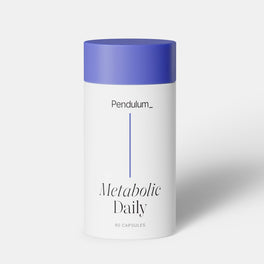Looks like your
cart is empty

Metabolic Daily
Improve metabolism

Akkermansia
Improves gut health

Polyphenol Booster
Increase antioxidants to protect cells
Stay in touch about special discounts, nutrition tips and additional education.
Looks like your
cart is empty

Improve metabolism

Improves gut health

Increase antioxidants to protect cells

Hope Warshaw is a Registered Dietitian (RD) and Certified Diabetes Care and Education Specialist (CDCES) who has been involved in diabetes care, education and support for over forty years. She has and continues to apply her credentials as a consultant, book author, freelance writer and media spokesperson within her business, Hope Warshaw Associates, LLC, a consultancy based in Asheville North Carolina.
Interest in how healthcare providers can apply precision medicine and—under this umbrella—"precision nutrition" to optimize health and manage diseases is gaining momentum.
This is true in general, and specific to Type 2 diabetes care.
This article defines key terms and summarizes conclusions from an interim consensus report from the Precision Medicine in Diabetes Initiative (PMDI).1
With this summary and acknowledgment that precision medicine for Type 2 diabetes care remains “aspirational,” this article encourages people with Type 2 diabetes to apply the body of knowledge we have today and work with a healthcare professional to personalize a healthy and sustainable eating plan.
What is precision medicine?
Precision Medicine means tailoring diagnostics or therapeutics (prevention or treatment) to subgroups of populations sharing similar characteristics, thereby minimizing error and risk while maximizing efficacy.1
More simply stated, providing the right therapy for the right person at the right time.1
What is precision diabetes medicine?
An approach to optimize the diagnosis, prediction, prevention, or treatment of diabetes by integrating data from various dimensions (e.g., diagnosis, treatments, monitoring techniques, etc.).1
The use of a complex array of data distinguishes precision medicine from standard medical care.
What is precision nutrition?
The customization of food and nutrient intake for individuals based on diagnostic testing, a person’s unique characteristics (e.g., DNA, race, gender, health history, and lifestyle) with the goal to more accurately implement disease prevention and management.2
The PMDI was launched in 2018 by the American Diabetes Association (ADA) in partnership with the European Association for the Study of Diabetes (EASD).1
The initiative’s long-term promise is to reduce the multiple burdens of the growing epidemic and human toll of diabetes around the globe.
The report states that the concept of precision medicine (see definition above) is not new, but what has evolved is the ability of experts to obtain, characterize and interpret human biological variation through science and technology.
PMDI is a multi-year initiative with four phases.1 In the early years, 2018 through 2025, the PMDI is focusing on assessing current evidence, promoting research, providing education, and developing guidelines for the application of precision medicine in diabetes care.
Phase four, the final phase, to take place starting in 2025, will communicate to and educate healthcare professionals and people with diabetes on the roadmap to implement an individualized, precise diabetes care regimen.
A phase one goal was to publish the consensus report.1 This lengthy and dense report provides a foundation for Precision Diabetes Medicine (PDM) (see definition above). Within it, the reader finds definitions of pertinent terms that focus on all aspects of this content from precision prevention to diagnosis (yes, we already know there are way more than two types of diabetes!), precision treatments (using data about a person’s unique biology and knowledge about treatments to provide a precise regimen), precision monitoring (including glucose monitoring and other biomarkers, like sleep, food choices, physical activity and more).
The report concludes by stating that for most types of diabetes, precision medicine at this point is, “aspirational, rather than standard of care.”

The PMDI report contains minimal details about nutrition and lifestyle interventions to reduce risk factors, prevent disease and manage diabetes.
It’s far from a deep dive on precision nutrition (see definition above). However, a recent debate at the ADA’s 2021 Scientific Sessions, Precision Nutrition – Are We There Yet?, did so with Paul Franks, Ph.D., Lund University Diabetes Center (Sweden), Harvard T.H. Chan School of Public Health, and co-chair of the PMDI, arguing yes. Kevin Hall, Ph.D., Section Chief, Integrative Physiology, National Institute of Diabetes and Digestive and Kidney Diseases at the National Institutes of Health, arguing no.3
Here are a few key takeaways:
Precision Nutrition: Ready for Primetime

There’s excitement about the promise of precision medicine and nutrition, but what is the consensus about how individuals with Type 2 diabetes should manage their food choices and eating habits today and tomorrow? That is before we can apply precision nutrition guidance.
Actually, there’s lots to chew on!
In 2019 the ADA published their latest Nutrition Therapy Consensus Report for adults with diabetes.4 A core principle reflects the goal of personalization and recommends that healthcare providers: “Address individual nutrition needs based on personal, cultural, literacy, numeracy, access to healthy foods, willingness and ability to make behavior changes understanding a person’s barriers.”4 This goal appreciates the reality that regardless of evidence-based guidance, a person’s eating habits and food choices, are wrapped up in so much more than simply choosing healthy foods in right-sized portions. The ADA Nutrition Therapy Consensus Report also dug into the existing data on a broad array of eating patterns that have been studied in people with diabetes, from Mediterranean to low carbohydrate, DASH and others.4 From this analysis they culled four commonalities among healthful eating patterns and recommended implementing these as a starter to make day-to-day food choices. They are:
For starters, it is essential to consume at a minimum 14 grams of fiber per 1000 calories a day.4,5 Dietary fibers help promote numerous reactions in the body that support health and minimize risks of some diseases. For one, some dietary fibers increase production of butyrate (an important short-chain fatty acid (SCFA) created in the gut microbiome through the breakdown of dietary fibers. Another step to consider is to use Pendulum Glucose Control, a synbiotic that contains five targeted bacterial strains (butyrate producers plus a mucin regulator) and the prebiotic inulin, to provide the initial food source for the probiotic strains. In a double-blind, randomized placebo-controlled study, in people with Type 2 diabetes on metformin, Pendulum Glucose Control, reduced A1c levels by 0.6% compared to placebo and generated a 33% reduction in postprandial glucose spikes (area under the curve).8,9
Curious to learn more about Pendulum? Click here to see Pendulum’s Story featured in ADA’s 2021 Scientific Sessions.
In summary, though it is interesting and enticing to glimpse into the future of precision medicine and precision nutrition, there are many evidence-based actions, as outlined here, to take today to prevent, delay and/or manage Type 2 diabetes. If you have Type 2 diabetes work with your diabetes care healthcare providers to personalize an eating plan that works for you over the long haul.
Remember you are an individual, or as they say, an N of one.